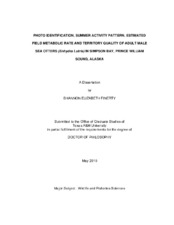| dc.description.abstract | This project describes a portion of a long-term study of the behavioral ecology of sea otters. Sub-studies of this project include the development of an individual recognition program for sea otters, the construction of male sea otter activity and energy budgets, and the assessment of male sea otter territory quality.
The Sea Otter Nose Matching Program, or "SONMaP", was developed to identify individual sea otters in Simpson Bay, Prince William Sound, Alaska, using a blotch-pattern recognition algorithm based on the shape and location of nose scars. The performance of the SONMaP program was tested using images of otters collected during the 2002-03 field seasons, and previously matched by visually comparing every image in a catalog of 1,638 animals. In 48.9% of the visually matched images, the program accurately selected the correct image in the first 10% of the catalog.
Individual follows and instantaneous sampling were used during the summers of 2004-06, to observe male sea otter behavior. Six behaviors (foraging, grooming, interacting with other otters, patrolling, resting, and surface swimming) were observed during four time periods (dawn, day, dusk, night) to create 24-hr activity budgets. Male sea otters spent 27% of their time resting, 26% swimming, 19% grooming, 14% foraging, 9% patrolling and 5% interacting with other otters. Field Metabolic Rate (FMR) was estimated by combining the energetic costs for foraging, grooming, resting, and swimming behaviors of captive otters from Yeates et al. (2007) with these activity budgets. "Swimming" accounted for the greatest percentage (43%) of energy expended each day followed by grooming (23%), resting (15%), feeding (13%) and other (5%). With a peak summer sea otter density of 5.6 otters km-2, the low percentage of time spent foraging indicates that Simpson Bay is below equilibrium density.
Territory quality was assessed for male sea otters using four attributes: territory size, shoreline enclosure, accessibility, and number of females observed feeding in each territory. Each attribute was coded with a score of 0-2, and total quality scores ranged from 0.14-1.96 (0.9 + 0.61 SD). High quality territories had large areas, moderate shoreline enclosure, high accessibility, and many foraging females. | en |


